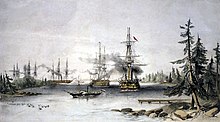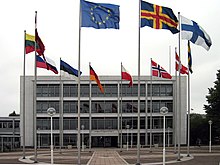Politics of Åland
This articleneeds additional citations forverification.(March 2010) |
 |
|---|
Politics of theÅland Islandstakes place in a framework of aparliamentaryrepresentative democraticautonomous,demilitarised, and unilingually Swedish territory ofFinland,whereby theLantrådis thehead of government,and of amulti-party system.
The Åland Islands are governed according to the Act on Åland Autonomy and international treaties, which guarantees autonomy and demilitarized status. TheGovernment of Åland,orLandskapsregering,is dependent on theParliament of Åland,orLagting,according to the principles ofparliamentarism.
In 1634, Åland was made part of theÅbo and Björneborg Countyas a part of the grand administrative reforms initiated by CountAxel Oxenstierna.The county became part of theRussian Empirewithin theGrand Duchy of Finlandin 1809, when Sweden was forced to cede vast areas in theNapoleonic Wars.When Finland declared its independence in 1917, the newly established state inherited the Åland islands.
During theCivil Warin 1918, some Russian troops were still stationed on the islands, causing serious instability and nervousness. This anxiety in the local population, and the otherScandinavianstates, resulted in a Swedish occupation and 7,135 people (of a total population of approximately 22,500 at the time) signing the address for Åland joining the kingdom of Sweden. The fear of Russia finally resulted in aGermanoccupation of the islands. In the meantime, the Finnish press was playing with the idea of an exchange of land areas between Sweden and Finland. The areas in question of this exchange would have been the Swedish-speaking Åland to Sweden and some Finnish-speaking areas ofNorrbottenandVästerbottento Finland. The response from the Swedish government was bluntly negative to any exchanges of this nature.
Since the 1920s, the primary political issue in Åland Islands relates to the promotion and protection of the self-government of the islands.[1]There is widespread political support for retaining self-government.[1]The sovereignty over Åland belongs to Finland, and Åland is thus notindependent.The Åland Islands areguaranteed representationin theFinnish parliament,and elect one representative.
In 1921 the question of Åland was brought to the council of theLeague of Nations.The council decided unanimously, that the islands would remain under Finland'ssovereignty,but stated that the native population's rights to their language had to be preserved, that the area had to stay demilitarized, and that Åland was grantedautonomyduring peacetime.[2]
Åland has its national flag, has issued itspostage stampssince 1984, has itspolice force,and is a member of theNordic Council.The islands are demilitarised, and the male population is exempted from conscription. Parliamentarism has been the custom since 1988. The Åland autonomy preceded the creation of theRegions of Finland,but the autonomous government of Åland also handles what the regional councils do.
Until the late 1970s, Åland politics was predominantly personalised, as politics was oriented around notable individuals.[1]In the late 1970s, a party system developed.[1]The prominent parties in Åland since 1979 are the Social Democrats, Centre, Liberals, and Moderates.[1]In comparison to the other Nordic countries, the political left is weak in Åland.[1]

Executive branch
[edit]
| Office | Name | Party | Since |
|---|---|---|---|
| Lantråd | Katrin Sjögren | Lib | 2015 |
| Other Government parties | MSÅ,ÅS |
In addition to Åland's government, theGovernment of Åland(Ålands Landskapsregering), there is also aState Department of Åland(Statens ämbetsverk på Åland), headed by the Governor,Peter Lindbäck,and which is a department of theGovernment of Finlandconcerned with its functions in the islands.
Legislative branch
[edit]TheParliament of Åland(Lagtinget,which means LawThing) has 30 members, elected for a four-year term byproportional representation.
Political parties and elections
[edit]Local government
[edit]- Municipalities of Åland,orKommuner
See also
[edit]- Politics of Finland
- Ting
- Swedish Assembly of Finland,orFolktinget
References
[edit]- ^abcdefArter, David (2022)."Personal representation or party representation? Elections in the autonomous Åland Islands".Regional & Federal Studies:1–14.doi:10.1080/13597566.2022.2047940.ISSN1359-7566.S2CID248113785.
- ^The Åland Agreement in the Council of the League of Nations 1921, Minutes of the Seventeenth Meeting of the Council, June 27th(archived link)
External links
[edit]- [1]– Official site
- Landskapsregeringen– Official site
- Act on Åland Autonomy– at Lagtinget

